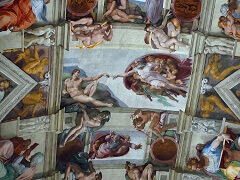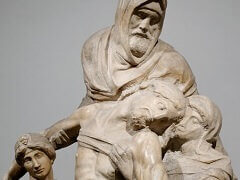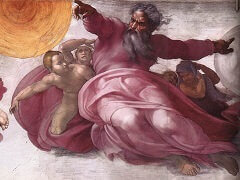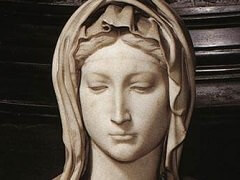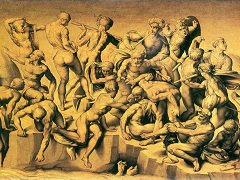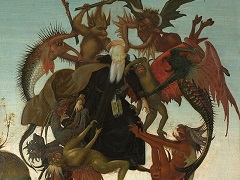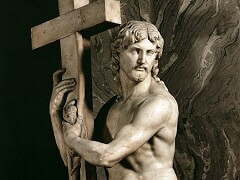The Creation of Adam, by Michelangelo

Of all the marvelous images that crowd the immense complex of the Sistine Ceiling, The Creation of Adam is undoubtedly the one which has most deeply
impressed posterity. No wonder, for here we are given a single overwhelming vision of the sublimity of God and the potential nobility of man unprecedented and unrivaled in the entire history of
visual art. No longer standing upon earth with closed eyes and mantle, the Lord floats through the heavens, His mantle widespread and bursting with angelic forms, and His calm gaze accompanying
and reinforcing the movement of His mighty arm. He extends His forefinger, about to touch that of Adam, who reclines on the barren coast of earth, barely able as yet to lift his hand. The divine
form is convex, explosive, paternal; the human concave, receptive, and conspicuously impotent. The incipient, fecundating contact about to take place between the two index fingers has often
been described as a spark or a current, a modern electrical metaphor doubtless foreign to the sixteenth century, but natural enough considering the river of life which seems about to flow into
the waiting body.
Genesis tells how the Lord created Adam from the dust of the earth and breathed into his nostrils the breath of life. This story is never illustrated literally in Renaissance art. Usually, as in
Jacopo della Quercia's beautiful relief on the facade of the church of San Petronio in Bologna, which must have impressed the young Michelangelo deeply, the Creator stands on earth and
blesses the already formed body of Adam, read together with the ground, since his name in Hebrew means earth. Michelangelo's completely new image seems to symbolize a still further idea - the
instillation of divine power in humanity, which took place at the Incarnation. Given Cardinal Vigerio's reiterated insistence on the doctrine of the two Adams, and the position of the scene
immediately after the barrier to the sanctuary, at the spot where the Annunciation customarily appeared, and after Ezekiel with his vision of the Virgin Birth, this would seem natural enough.
The scene recalls the famous verses from Isaiah, "Who hath believed our report ? and to whom is the arm of the Lord revealed ? For he shall grow up before him as a tender plant, and as a root
out of a dry ground . ..," invariably taken by theologians to foretell the Incarnation of Christ, shoot of Jesse's rod. Two striking visual elements make clear that this was one of the passages
that actually recommended to Michelangelo by his probable adviser, Cardinal Vigerio. First, the mighty right arm of the Lord is revealed, naked as in no other of His appearances on the Sistine
Ceiling, nor anywhere else, as far as I have been able to determine, in all of the Christian art prior to this time. (The left arm is clothed, at least to the elbow, by a white sleeve.) Second,
directly under Adam, the arm of the veiled youth to the left above the Persian Sibyl projects into the scene - a matter that involved considerable advance planning - coming as close to touching
Adam's thigh as the Creator does his finger. This hand holds a cornucopia bursting with Rovere leaves and acorns, appearing to grow from the dry ground, as full of potency as Adam ("ground") is
empty of it. Such an image is characteristic not only of Michelangelo, who insofar as possible preferred to show male figures, including that of Christ, completely naked, but of the Roman High
Renaissance and of Julius II himself, whose language as recorded by his astonished contemporaries overflows with boasts of his own physical strength and potency.


